What is In-mold Decoration?
In-mold Decoration is a process in which a pre-printed film (In-mold Decoration foil) is inserted into a mold, plastic resin is filled into the mold and then only the printed graphic is transferred during the injection process by the heat and pressure of injection molding. Unlike traditional post-mold decorating technologies, the In-mold Decoration alternative makes it possible to effectively create more beautiful exterior designs. This is a groundbreaking technology that was developed by YOSHIDA TECHNOWORKS in 1973.
We have continued to make technological advances around our proprietary In-mold Decoration technology and have developed various In-mold Decoration technology, including double-sided In-mold Decoration, a process that enables the front and rear surface of molded products to be decorated simultaneously, NCVM In-mold Decoration for a beautiful metallic finish without signal interference, indium In-mold Decoration, a two-shot In-mold Decoration technology that gives greater depth to the decoration by leveraging the texture of plastics and high contrast colors, and Glass Insert Molding with In-mold Decoration, a technology that fuses glass and resin together seamlessly for greater adhesion and water repellence.
Double-sided In-mold Decoration
A revolutionary molding technology that enables the decoration of both front and rear surfaces of plastic products.
Utilizing the thickness of plastic, it is now possible to create colorful designs with a sense of depth with ever-shorter lead times.
Double-sided In-mold Decoration
Cutting-edge In-mold Decoration technology developed by YOSHIDA
-
Double-sided In-mold Decoration using optical film
 Combining optical film with piano black film or film that has been pre-printed with an icon yields panels with amazing depth.
Combining optical film with piano black film or film that has been pre-printed with an icon yields panels with amazing depth.
-
Retardation-eliminating technology
 Our unique technology solves the problem of polarization distortion that occurs when molding large panels or curved designs.
Our unique technology solves the problem of polarization distortion that occurs when molding large panels or curved designs.
-
Amalgamating glass and plastic through technology
 Integral molding of glass and plastic results in airtight adhesion of the main body with the glass cover for improved waterproofing.
Integral molding of glass and plastic results in airtight adhesion of the main body with the glass cover for improved waterproofing.
-
Decoration technology for box-geometry
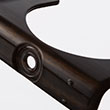 High-yield, high-quality decoration for box-geometry products where coating and vacuum deposition can be difficult.
High-yield, high-quality decoration for box-geometry products where coating and vacuum deposition can be difficult.
The advantages of plastic
Ceramics, metal, rubber and plastic are all used in manufacturing, though plastics are the newest material, and with advances in plastic materials and their manufacture, these materials have become indispensable in all manufacturing fields.
Opportunities for plastic are expanding as energy conservation requirements in recent years increase demand for lighter-weight products and packaging.
-
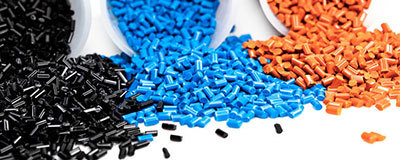
Many types with different characteristics
Plastics come in numerous varieties, allowing manufacturers to select the best material for their required product characteristics.
-

Light and strong
Not only are plastics light, but there are numerous high-performance plastics, such as engineering plastics, that have higher tensile strength and other enhanced properties.
-
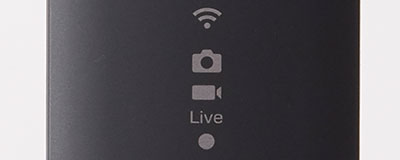
Excellent designability factor
Delivering color is easy and In-mold Decoration foil makes it possible to decorate product surfaces in many ways, making it possible to accommodate all levels of design complexity.
-
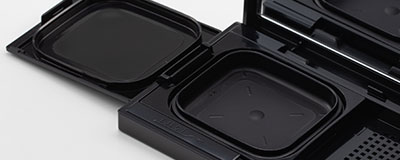
Well-suited for complicated geometry and processes
Since plastics are easy to mass produce, they are also well-suited for delicate geometry and processes
-
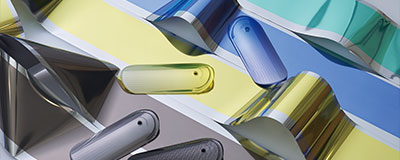
Non-corrosive
Plastic products never corrode or rust, and remain beautiful

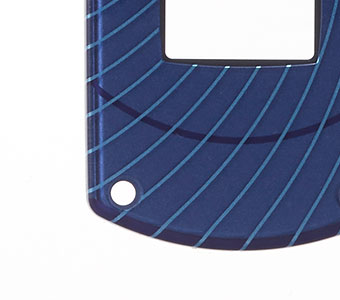
 Combining optical film with piano black film or film that has been pre-printed with an icon yields panels with amazing depth.
Combining optical film with piano black film or film that has been pre-printed with an icon yields panels with amazing depth.
 Our unique technology solves the problem of polarization distortion that occurs when molding large panels or curved designs.
Our unique technology solves the problem of polarization distortion that occurs when molding large panels or curved designs.
 Integral molding of glass and plastic results in airtight adhesion of the main body with the glass cover for improved waterproofing.
Integral molding of glass and plastic results in airtight adhesion of the main body with the glass cover for improved waterproofing.
 High-yield, high-quality decoration for box-geometry products where coating and vacuum deposition can be difficult.
High-yield, high-quality decoration for box-geometry products where coating and vacuum deposition can be difficult.





